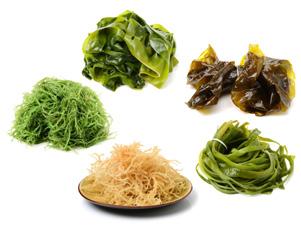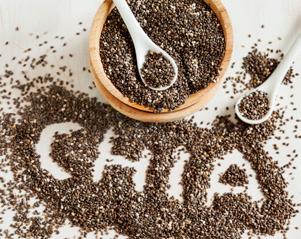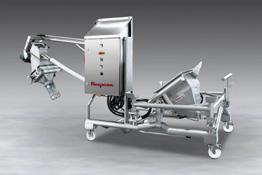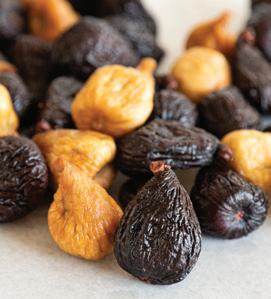The functional food revolution
THE PROMISE OF PURPLE WHEAT

» The science of food and beverage ISSUE 3 • 2022
PUBLISHER & CEO Christopher J. Forbes cforbes@jesmar.com
MANAGING EDITOR Sean Tarry starry@dvtail.com

COPY EDITOR Mitchell Brown
CONTRIBUTORS El-Sayed M. Abdel-Aal Richard Baker Vasantha Rupasinghe Yvonne V. Yuan
SENIOR Leesa Nacht ACCOUNT lnacht@dvtail.com EXECUTIVE
ART DIRECTOR Sharon MacIntosh smacintosht@dvtail.com
SECRETARY/ Susan A. Browne TREASURER
MARKETING Stephanie Wilson MANAGER swilson@jesmar.com
PRODUCTION Crystal Himes MANAGER chimes@jesmar.com
CANADIAN FOOD BUSINESS ADVISORY COMMITTEE
Marcia English, Associate Professor, St. Francis Xavier University
Michael Nickerson, Saskatchewan Research Chair and Professor, University of Saskatchewan Hosahalli Ramaswamy, Professor, McGill University Amanda Wright, Association Professor, University of Guelph
Canadian Food and Business is published 4 times per year by Jesmar Communications Inc., 30 East Beaver Creek Rd., Suite 202, Richmond Hill, Ontario L4B 1J2 905.886.5040 Fax: 905.886.6615 www.canadianfoodbusiness.com One year subscription: Canada $35, US $35 and foreign $95. Single copies $9. Please add GST/HST where applicable. BioLab Business subscription and circulation enquiries: Garth Atkinson, biondj16@publicationpartners.com Fax: 905.509.0735 Subscriptions to business address only. On occasion, our list is made available to organizations whose products or services may be of interest to you. If you’d rather not receive information, write to us at the address above or call 905.509.3511. The contents of this publication may not be reproduced either in part or in whole without the written consent of the publisher. GST Registration #R124380270.
PUBLICATIONS MAIL AGREEMENT NO. 40063567 RETURN UNDELIVERABLE CANADIAN ADDRESSES TO CIRCULATION DEPT. 202-30 EAST BEAVER CREEK RD RICHMOND HILL, ON L4B 1J2 email: biond@publicationpartners.com
BioLab Business, a sister publication of Canadian Food Business, is a proud member of BioteCanada and Life Sciences Ontario.
APPETITE FOR FUNCTIONAL FOOD AND BEVERAGES GROWS
The COVID-19 global pandemic has resulted in a whole host of impacts that have influenced the daily lives of Canadians in every province and territory from coast-to-coast-to-coast. Some of the impacts and subsequent influences have been picked up by media and covered extensively, such as recurring lockdowns and the accelerated digitization of the world around us that it helped spark, changing forever the way we find, share, and consume information.
Social restrictions and protocols imposed by governments have also altered the way people engage in public and the traditional modes of working. In short, circumstances over the course of the past couple of years have resulted in adjustments to just about everything that we do. However, perhaps much more meaningful than the modifications that the pandemic has affected is the shift in mindset among the average Canadians that has included a greater focus on their health and wellness.
It’s an intensified focus that’s caused a cascade of ripples throughout a number of markets and sectors. But the one that seems to have been impacted more than any other, finding itself as one of the primary beneficiaries of a more healthconscious Canadian, is the functional food and beverage sector and its adjacent providers. The global functional food ingredient market alone is set to hit $118.4 billion by 2026, casting a brighter light on the actual function and utility of functional foods.
Within this issue of Canadian Food Business, we attempt to uncover the trends within the functional food and beverage market that are resulting from the shift in mindset among the general public, determine where the growth is most significant, and identify opportunities for further growth of the sector.
We highlight the attributes of purple wheat, its potential to be used as a healthy food ingredient, and the benefits that result from its measured consumption. And, we also explore some functional foods that you may not have heard of before.
Sean Tarry EDITOR
We hope that the content that we’ve served up within this issue of Canadian Food Business provides those working within the country’s food innovation industry with something to chew on, as the slice of the functional food and beverage pie continues to grow.
In 2022 the Canadian Institute of Food Science & Technology (CIFST) and Canadian Food Business magazine launched a partnership to create a platform for leading experts, innovators and scientists to showcase the latest trends, knowledge and developments that are changing the face of Canada’s food industry today. For further information contact sbrowne@dvtail.com
Publisher of BioLab Business Magazine
Printed in Canada
EDITOR'S NOTE CANADIAN FOOD BUSINESS VOLUME 36, ISSUE 6 • 2022 26
COLOUR ME PURPLE 39

FIVE FUNCTIONAL 41 FOODS THAT YOU MAY NOT

HEARD
THE FUTURE OF FUNCTIONAL FOODS IN CANADA AND THE EVOLUTION OF FOOD BIOACTIVE CONCEPTS

36 inside standard GUEST EDITORIAL 30 NEWS BITES 32 FOODWARE 44 feature INDUSTRY REPORT 34 THE STATE OF THE GLOBAL FUNCTIONAL FOOD INGREDIENT MARKET FEATURES
Growing consumer demand for functional foods in Canada leading to big opportunities for innovation within the industry
The Production of Purple Wheat is Resulting in a Promising Healthy Food Ingredient and a Growing Market
HAVE
OF BEFORE CANADIANFOODBUSINESS.COM 27
2022 FCC Beverage Report:
Demand shifting from retail to service
The annual FCC Beverage Report highlights opportunities and risks for Canadian beverage manufacturers. It includes an annual sales forecast for 2022, product sales performance and a gross margin rate index.

Industries featured in the report are:
• Breweries
• Wineries
• Distilleries
• Soft drinks and other non-alcoholic beverages
Dairy and fruit/vegetable-based beverages are covered in our food report under the dairy and fruit and vegetable manufacturing industry sections.
The pandemic shifted consumer purchases from food service to retail, limiting a revenue stream with usually strong margins for most beverage manufacturers. In 2021, consumers started to shift their purchases back to the service industry; however, lingering restrictions and higher production costs reduced profitability.
Three key observations from this year’s report:
1. Beverage manufacturing sales increased in 2021
Increased foodservice volumes and continued retail growth boosted total sales 11.3% YoY to $14.5 billion in 2021 (Table 1).
Beverage manufacturing sales are projected to decrease 1.0% in 2022, driven by:
• Broad inflation shifting consumers’ choices
• Elevated wholesale/retail inventory levels limiting downstream sales
• Shift towards service-based sales where consumers tend to drink fewer alcoholic beverages than at home
FCC Economics expects sales declines coming from larger alcoholic businesses focused on retail, with smaller operations (who represent a minority of total revenues) benefiting from growth in the service industry and a return to selling direct to consumers. Companies with a diversified portfolio of beverages catering to different audiences will outperform (for example, beer and seltzer, caffeinated and non-caffeinated).
Table 1: Manufacturing sales and exports grew in 2021 YoY
2021 (millions $) YoY % change 2020 (millions $) YoY % change
Beverage manufacturing sales 14,555 11.3 13,080 3.0
Beverage exports 1,458 3.8 1,405 2.1
Beverage imports 6,157 3.6 5,945 1.2
Beer, wine and liquor retail sales 26,445 2.5 25,800 6.6
Bar sales 1,554 12.7 1,379 -44.2
Total estimated alcoholic retailfocused sales
Source: Statistics Canada
27,999 3.0 27,179 1.9
2. Industry gross margins expected to improve
Supply-chain disruptions lowered the availability of key packaging and raw inputs, driving up costs. Despite growing topline sales, gross margins struggled to regain 2019 levels (Figure 1). Strong competition in the alcoholic beverage sector makes it difficult to pass on higher costs, resulting in beverage inflation lagging food inflation. We expect margins to improve in 2022 as consumers are willing to pay higher prices for beverages, assuming costs don’t continue to rise. Bar, taproom, wine tasting rooms and restaurant sales are also often at a higher margin than retail. Non-alcoholic companies successfully pass on cost increases with little impact on volumes year-to-date and overall supporting margins.
consecutive years. Canadian breweries have taken market share from internationally produced beer over that timeframe, although their volume has also declined, just at a smaller rate. Overall, beer’s market share compared to wines and liquor fell by two percentage points to 36%. Gains in distilled beverages came from growing demand for hard seltzers, which many breweries are shifting focus towards to offset declines in market opportunities for beer.
2: Beer lost retail market share in Canada
2020-21 marketing year
Beverage type Total beverage market share
YoY % change
3. Beer remains the number one alcoholic choice among Canadians but also faces pressure
Beer sales at the retail level for the 2020-21 year declined 1.4%, with total litres sold falling 2.3%. Total beer volumes have now declined for five
Distilled liquor

The bottom line
Low retail inflation relative to rising input costs is a trend to monitor. Look for data-driven ways to boost margins, manage inventory, product mix and pricing strategies. Find ways to maintain or grow market share by connecting with Canadian consumers, through tourism or capitalizing on their desire for niche and “locally produced.” The alcoholic beverage market is competitive; however, product innovations, including seltzers, pre-mixed drinks, non-alcoholic drinks and other beverages,
supporting growth.
are
Read the full report at fcc.ca/BeverageReport Kyle Burak, FCC Senior Economist
%
Beer 36.0 -2.0 Wine 33.8 -0.6
30.2 2.7 Table
in the
Source: Statistics Canada (Apr 2020 – Mar 2021) *Performance does not line up with calendar manufacturing sales due to timing and inventory levels at wholesale and retail stores. Figure 1: 2021 beverage gross margin rates remained below pre-pandemic levels Source: Statistics Canada, FCC Economics 99.4 2018 100.0 2019 94.2 2020 97.4 2021 102 100 98 96 94 92 90
The rise of functional food and beverages
Who is the sector’s consumer and what’s driving the market’s growth?
By Richard Baker
We consume foods for many reasons: for basic physiological needs, for sensory pleasures, and for the social occasions it facilitates. Increasingly, especially throughout the pandemic, consumers have focused more intensely on foods and beverages that contribute to their health and wellness, with a strong emphasis on functional foods and beverages. During the pandemic, 4 in 10 consumers purchased such products. This emphasis is solidified by McKinsey & Co’s Future of Wellness survey which revealed that 79% of worldwide consumers believe that wellness is important, with 42% considering it a top priority.
Consumers are increasingly taking their health into their own hands. They understand the correlation between food and health and seek foods and beverages that will help them more aggressively meet their unique nutrition and personal health goals.
The Canadian functional food and beverage market is projected to reach $19.2B by 2026, growing at an anticipated Compounded Annual Growth Rate of 6.3% between the period 2021-2026. Functional food ingredients that support better

sleep, reduce stress and improve focus are in demand and driving product innovation.
Interestingly, the strongest demand for functional food and beverages is from consumers under the age of 55. They are more aware of and utilize products that offer functional benefits. Shifting demographics are positioning this market for sustained growth, as Millennials and Gen Z are already the most engaged demographic in functional product usage and are significantly more focused on foods that support both mental and physical well-being. Those consumers over the age of 65 also represent opportunities to grow the audience for this sector.
When asked “which were the reasons” for purchasing functional food and beverages, the immune system (58%), and healthy bones and joints (46%) were the top two responses, followed by digestive health (43%), heart health (40%) and improved energy (39%).
Given the fact that the interest in health and wellness has never been higher, let’s take a more in-depth overview of the top five responses for purchasing functional foods and beverages:
GUEST EDITORIAL
CANADIAN FOOD BUSINESS VOLUME 36, ISSUE 6 • 2022 30
1. Immune System Health: Consumers are seeking protection against illness and disease, from COVID-19 to the common cold and other ailments in between. Consumers seek products that are rich in nutrients and present a great flavour. 70% of global consumers have changed their diet and lifestyle in a bid to improve their immunity.
2. Healthy Bones and Joints: As we age, the risk of bone and joint issues such as osteoporosis and rheumatoid arthritis increases. This is the main concern for mature adults over the age of 51 and clean label products, as well as products that offer preventative health, are in high demand.
3. Digestive Health: Consumers associate good digestive health with overall wellness. Strong digestive health allows the body to properly break down food and absorb nutrients to keep the body healthy. Consumers with strong digestive systems are less likely to experience heartburn, bloating, and indigestion.

4. Heart Health: Your heart is a muscle and strengthens with exercise. Three keys to a strong heart include 1) weight loss, 2) the consumption of heart-healthy foods, and 3) the reduction of stress levels.
5. Improved Energy: Consumers seek products to boost struggling energy levels. One in three consumers report feeling tired and lacking energy. Seven in 10 consumers seek out food and drink to boost their energy level.
While the pandemic may have accelerated this trend, dramatically impacting the way in which consumers view wellness, with a stronger emphasis on “better” health, fitness, nutrition, appearance, sleep, and mindfulness, functional foods are proving to be no flash in the pan. And, as today’s consumer continues to evolve, it seems we’re collectively allowing food to be our medicine and medicine to be our food.
GUEST EDITORIAL
CANADIANFOODBUSINESS.COM 31
Cyber attacks on Canada’s food supply are a growing threat

The rise in smart farming has exposed vulnerabilities to cyber threats in Canadian food production, distribution and global food supplies, according to new research by a joint team of computer and food scientists out of the University of Guelph (U of G). They are hoping their findings will help arm food producers against such attacks and spur the Canadian government to develop data security standards for the agricultural sector.
To help ensure food security, producers are increasingly adopting smart farming and precision agriculture technology to grow and raise more food while reducing environmental impacts and waste from fertilizers and pesticides. But all those interconnected sensors, smart meters, cameras, and other devices leave farmers more vulnerable to “data insecurity” and potential cyberattacks.
“The level of cybersecurity protection in agriculture is minimal to non-existent. We need to think about it before things get out of control,” warns U of G’s Ali Dehghantanha, Canada Research Chair in Cybersecurity and Threat Intelligence at U of G.
Dehghantanha’s lab is the only Canadian university research centre investigating the increased number of cyberattacks on farm networks. To do so, he teamed up with U of G food experts on a first-time study of smart farming and cyber threats which included a 2022 survey of on-farm wireless technologies.
It follows a 2020 market research study he co-authored that found the global smart agriculture market had grown to more than $10 billion by 2019. Meanwhile, spending on cybersecurity in smart agriculture accounted for only about 3% of total cybersecurity spending in North America.
Dehghantanha advises that farmers need to make sure their technology can ward off three main kinds of threats: ransomware which freezes digital assets until owners pay a hefty sum; theft of confidential information, later sold to competitors; and, disruption or control of network systems.
“Any [such] disruption of infrastructure could cause disruption of the supply chain and affect food security,” he warns.
He goes on to say that farmers need to practice “cyber hygiene” by updating systems, protecting private information, and using authentication and password procedures. He urges producers to consider deploying cyberthreat monitoring systems available from various companies. And he suggests that producers build relationships with system vendors to ensure prompt response if problems occur.
Investing in Indigenous food sources to aid food security in the North
Traditional foods from wild animals and plants have long been a source of healthy and sustainable nutrition for Indigenous and Northern communities. Now, in response to a call for greater access to traditional foods by Indigenous leaders, the Canadian government has invested $383,000 to support a two-year project to boost local reindeer herds. With guidance from trained and professional herders and the support of community members and partners, the goal is to grow the reindeer population so it can be a sustainable source of nutrition, hides and crafting supplies, and provide local employment and training opportunities.
Cell-based aquaculture to augment depleting fish
Umami Meats recently unveiled the world’s first cultivated fish ball laksa. Umami is a cellular agriculture startup company developing sustainable alternatives to traditional fish production. The cell-based fish balls are made from cultivated fish. Then, they are supplemented with plant proteins to give them a similar taste and texture to that of traditional fish balls.

Report shows you can grow more crops while reducing greenhouse gases
Over the next 50 years, farmers will need to produce more food than has been grown in the last 10,000 years. The Fertilizer Agri-Economics Study, recently released by Fertilizer Canada and the Canola Council of Canada, shows that aggressively adopting principles of good nutrient stewardship in agriculture (4R Best Management Practices), can achieve a 14% reduction in greenhouse gas emissions by 2030 without jeopardizing food security.
NEWS BITES
CANADIAN FOOD BUSINESS VOLUME 36, ISSUE 6 • 2022 32
Four innovative Canadian projects get funding boost for food safety and sustainability
The Canadian Food Innovation Network (CFIN) has announced an investment of $338,000 into four projects.
Trendi Tech from Burnaby, BC, is working on new avenues to use rescued foods and repurpose ingredients to make soups and smoothies from food wastes for its line of healthy option vending machines. The funding will go to jump starting the design for a hot soup kiosk using the company’s own freeze-dried products, explains Trendi Tech CEO, Craig McIntosh.
Operating out of Calgary, Nutrimeals is a digital platform that uses AI to deliver meals customized to a consumer’s dietary needs. It received funding to digitize its e-commerce platform and logistics model. “We are passionate about making healthy eating accessible,” said Samuel Hale, Nutrimeals’ co-founder. The project aims to advance personalized meals and access to precision nutrition.
Henry’s Tempeh from Kitchener, ON, was the third recipient of CFIN funding for developing a solid-state automated tempeh incubator that can scale up to produce industrial quantities of tempeh, with the ability to ferment Canadian pulses. The company plans to use the funding to develop non-soy fermentation and a smart fermentation system said Jason Jurchuk, President.
In Toronto, ON, Index Biosystems will apply CFIN funds toward automating its BioTag application system— microscopic barcodes that tag and trace grain across the supply chain. The company uses biotechnology to turn baker’s yeast into microscopic barcodes for a secure link between a product and its supply chain data. It aims to enhance food safety, traceability, and sustainability across the food value chain.
“With BioTags, we can authenticate individual grains at commodity scale,” says Michael Borg, CEO at Index BioSystems.
A second round of Innovation Booster funding, looking at food ecosystem sustainability, closed in September. The Innovation Booster, which is administered by CFIN and supported by Canada’s Strategic Innovation Fund, supports small and medium businesses pushing the boundaries of food innovation while grappling with technical hurdles.
Creating starch with a low glycemic index

German food ingredients producer, Loryma, working with the ZIEL Institute for Food & Health at the Technical University of Munich, have created a low glycemic index wheat starch and dietary fibre substitute with an index value of 4, compared to native wheat starches which typically carry a value of 50. The new Lory Starch Elara is only partially digested and contributes to satiety.
Taiyo’s functional drinks now include a sleep aid
An innovative beverage concept called Sleepwater has been unveiled by Taiyo which markets its functional foods both in Canada and worldwide. The beverage is specially designed for consumers who have difficulty falling asleep or sleeping through the night and incudes L-theanine, a compound that promotes relaxation and helps reduce stress.

Climate-friendly foods debut in university dining halls
Food service giant, Aramark, has introduced climatefriendly meals on residence dining menus at 15 universities and colleges in Canada. Working with the World Resources Institute, a global market research firm, Aramark identified 250 Cool Food Meals based on their ingredients and the land used to produce the meals.
NEWS BITES
CANADIANFOODBUSINESS.COM 33
The state of the global functional food ingredient market

Buoyed by continued growth, opportunities are abundant for those operating within the bourgeoning sector
By Sean Tarry
The Global Functional Food Ingredients Market Report
2022 was released this past spring, revealing expectations around continued growth of the market that industry observers are anticipating will reach $118.4 billion by 2026.
It’s impressive growth for the still burgeoning sector— growth that will be reflected by a compounded annual growth rate of 7.6% over the reports analysis period. And, when it comes to the functional food ingredient phenomenon, the report suggests that the primary driver of the groundswell of popularity is today’s increasingly health-conscious and wellness-inspired global consumer.
Increased appetite
Findings within the report suggest that enhanced awareness concerning the benefits of safe fortified foods and how they can help contribute toward an enjoyable life have lent to an increased appetite for the sector’s wares among the general public. In turn, a greater understanding of the ways in which functional food ingredients can help to prevent the onset of a number of different chronic diseases, including high blood pressure and diabetes has been developed, enhancing the standing of the sector further.
INDUSTRY REPORT
CANADIAN FOOD BUSINESS VOLUME 36, ISSUE 6 • 2022 34
The report goes on to suggest that there are a multitude of other factors that are helping to drive increased adoption and use of functional food ingredients and the subsequent growth of the sector. They include:
• Growing numbers of gym-goers and fitness centres
• Changes in the regulations for the food and beverage sector in countries and regions around the world
• Increasing consumer demand for wholesome and cleanlabel food and beverage products with high nutritional content
• Product innovations, developments, new investments, and new product launches by many companies are piquing interest among consumers
• Growing focus on healthy lifestyles amidst the ongoing pandemic drives focus toward functional foods, driving demand for ingredients
• Focus grows concerning natural foods and clean label
• Consumers’ focus on less processed foods drives market prospects
• Increasing prevalence of chronic and lifestyle diseases enhances consumer spending on functional foods and boosts demand for ingredients
• Growing prominence of functional foods and drinks in weight management facilitates market demand
• Increased plant-centric demand and availability of plants in convenient formats
• Increased use of plant milk for digestive wellness
• Increased awareness around the use of prebiotics as an important ingredient promoting gut health, brain health, and immunity
• Exploration of the potential role of prebiotics and probiotics in the prevention and treatment of Coronavirus infections
• Trend towards higher fiber consumption drives demand for prebiotic fibers
• Antioxidants gain importance in functional beverages
• The entry of soy-based functional ingredients into the mainstream
• Growing use of carotenoids in functional foods and beverages
• Emergence of omega-3 as a popular heart-healthy ingredient
Rise in demand of protein-fortified products
• Emergence of rice protein as a functional ingredient
• Emergence of dietary fat as a new ingredient for functional food and drinks
• Increased demand for functional ingredients in snack foods
• Rising consumer interest in fruit-based functional ingredients
• Rising demand for natural ingredients in functional foods
• Wide-ranging benefits related to endurance, cardiovascular, and bone health drives robust demand for protein-based products
• Increased interest in mood enhancers
• Increased innovation driving market expansion
• Millennials’ focus on health and wellness
Market analysis
The report identifies the United States as the largest market posing the greatest potential growth for the functional food ingredient sector, which is currently estimated at USD$25.6 billion in 2021, accounting for a 30.93% share of the global market.
Trailing the United States in terms of market share and growth potential is the world’s second largest economy, China, which is anticipated to reach an estimated USD$14.1 billion by 2026 with a compounded annual growth rate of 10.5%, followed by Japan and Canada, each forecast to grow at 6.2% and 6.6%, respectively.
Germany is the leading European nation when it comes to growth potential for the functional food ingredient market, which is forecast to grow at approximate compounded annual growth rate of 5.7%. The remainder of the EU is expected to reach a cumulative US $15.4 billion by 2026.

Here at home
The Canadian market is also highlighted within the report, identifying the unique drivers influencing the growth of the sector within the country. It reveals that an increased focus on health and wellness and concerns related to complications including diabetes, obesity, and digestive disorders are the factors bearing the most significant impacts. It also identifies Canada as a key supplier of functional ingredients and foods, positioning it well for further growth beyond the report’s analysis period.
To access the full version of the Global Functional Food Ingredients Market Report 2022, visit https://www.researchandmarkets.com
INDUSTRY REPORT
CANADIANFOODBUSINESS.COM 35
The future of functional foods in Canada AND THE EVOLUTION OF FOOD BIOACTIVE CONCEPTS
Growing consumer demand for functional foods in Canada leading to big opportunities for innovation within the industry
By H.P. Vasantha Rupasinghe, Professor of Functional Foods & Nutraceuticals, Department of Plant, Food, and Environmental Sciences, Dalhousie University

FEATURE
CANADIAN FOOD BUSINESS VOLUME 36, ISSUE 6 • 2022 36
The COVID-19 pandemic has influenced our dietary habits and inspired some food bioactives. Canadians seem to be not too dissimilar from the rest of the world when it comes to choosing their food. Consumers’ belief in food as medicine is increasing as seen by elevated sales of functional foods and beverages. Consumers are thinking of a more preventive approach to health and specifically seeking foods and beverages that could support immunity directly or through an enhanced gut microbiota. This is an opportunity for the functional food industry to innovate new food and beverage products.
Young consumers are also looking for sustainably healthy food with ethical and humane production. The pandemic has also forced us to think about homegrown food, ways to extend the growing seasons, controlled-environmental and vertical farming, automation and robotics for farms and food manufacturing, and non-conventional food delivery systems.

The trends in plant-based foods, especially protein, also continue to grow and are a development in the mitigation of GHG emissions and sustainable food production for the growing global population. The importance of incorporating bioactives in a healthy diet to reduce the risk of non-communicable diseases (NCDs), as well as to manage infectious diseases including COVID-19, has also been revealed and could play a significant role in protecting the health of a growing elderly population in Canada as well as to combat the increasing prevalence of cancers, cardiovascular diseases, and type 2 diabetes.
What are functional foods and food bioactives?
Food can be regarded as "functional" if it is shown to benefit one or more target functions in the body, beyond adequate nutrition, in a way that improves health and well-being or reduces the risk of disease. The concept of functional food is built around what Hippocrates, the father of medicine, stated thousands of years before: “Let thy food be thy medicine and thy medicine be thy food.”
However, over time, rapid advancements in food production after the green revolution, in combination with changing lifestyles, have made our regular diet nutritionally imbalanced, energy-dense, and deficient in bioactives. Food bioactive refers to the non-nutrient, naturally occurring constituents of food that have protective effects against NCDs.
Bioactives do not have a direct role in growth and development or in preventing typical deficiency conditions. Food bioactives are sometimes called nutraceutical
ingredients and can be classified into many sub-groups of flavonoids and other polyphenols, carotenoids and other isoprenoids, glucosinolates, omega-3 fatty acids, bioactive peptides, prebiotics and probiotics and some minerals. For example, polyphenols, especially catechins, are the primary food bioactive of green tea that provide antioxidative and other physiological functions, bringing health benefits that extend beyond those of basic nutrition.
Now, the governments of many countries around the world have started initiatives to facilitate the rebirth of this ancient concept in a much more sophisticated and regulatory environment. For example, in 1991, Japan first introduced the world to ‘functional foods’ through Foods for Specified Health Use (FOSHU). In the US, a few health-related statements or claims are allowed on food and dietary supplement labels. The US FDA approves health claims confirming a relationship between components in the diet and risk of disease or health condition, supported by significant scientific agreement. Countries such as China and South Korea have even made Recommended Dietary Allowances (RDA) for common food bioactives such as soy isoflavones.
Functional foods: the Canadian versions
In Canada, though there are no formally recognized functional foods, there are some categories of regulated specialized food which bear some aspects of the concept of functional foods. For example, supplemented foods are broadly defined as pre-packaged products that are manufactured, sold or represented as food, which contain added bioactive or herbal ingredients, vitamins, minerals, or amino acids. These ingredients may perform a physiological role beyond the provision of nutritive requirements. It seems that plant ingredients incorporated into supplemented food are growing in Canadian groceries.
FEATURE
CANADIANFOODBUSINESS.COM 37
Health Canada also allows foods with nutrient claims. The function claims are for the specific component of the food. For example, docosahexaenoic acid (DHA)-containing foods could claim: “DHA, an omega-3 fatty acid, supports the normal physiological development of brain, eyes, and nerves primarily in children aged under 2 years.” For the foods with probiotic claims, speciesspecific claims are accepted if a serving contains a minimum of 1 billion colonyforming units of one or more eligible microorganisms. A few disease risk reduction claims are allowed on food labels in Canada: for example, “A healthy diet rich in a variety of vegetables and fruit may help reduce the risk of heart disease” and “Selenium helps against oxidative stress.” Novel food ingredients undergo a mandatory pre-market assessment prior to being authorized for sale in Canada. Marketers require a Temporary Marketing Authorization Letter (TMALS) from Health Canada.
Future of Canadian functional food: Challenges and prospects


In order to continue advancing the functional food sector, and to provide true physiological health benefits to consumers, it is critical to establish Dietary Reference Intakes (DRIs) for common food bioactives. Health Canada and respective research institutes are required to work closely to establish DRIs to develop effective and safe doses to guide food manufacturers. It is also required to educate Canadians on food bioactives. The impact of nutrition and food bioactives should be included in the Canadian education system, including medical schools.

A survey conducted among Canadians in 2021 by Dalhousie University indicates that only 21.4% of Canadians will think about food’s bioactive properties when purchasing fruits or vegetables. However, 48% of Canadians eat fruits and vegetables to reduce cancer risks. These trends indicate that there are a lot of prospects to bring the concept of functional foods to Canadian consumers. The same survey indicated that the major barrier to fruit and vegetable consumption is the cost (39.5%). Thus, the promotion of bioactive enriched fresh or supplemented food as functional foods requires government policies to make them available at affordable prices.
With the recent trends in foods, Canada has comparative advantages to manufacture many functional foods and ingredients for the local and global market. These include, but are not limited to, pulse protein hydrolysates and bioactive peptides, healthy vegan lipids from oil seed crops and cultivated microalgae, prebiotic fibres from diverse crops, their processing by-products, upcycled ingredients, and immunity-enhancing phytochemicals and micronutrients from cultivated super-berries and vertically farmed green leafy vegetables. In Canada, innovative food manufacturing is urgently required for promoting and expanding fermented food and gluten-free supplemented food for special dietary use such as weight management, cognitive health, and healthy aging.

FEATURE
M CM MY CMY CANADIAN FOOD BUSINESS VOLUME 36, ISSUE 6 • 2022 38
Young consumers are also looking for sustainably healthy food with ethical and humane production.
THE PRODUCTION OF PURPLE WHEAT IS RESULTING IN A PROMISING HEALTHY FOOD INGREDIENT AND A GROWING MARKET
 By El-Sayed M. Abdel-Aal, Research Scientist, Guelph Research and Development Centre, Agriculture and Agri-Food Canada
By El-Sayed M. Abdel-Aal, Research Scientist, Guelph Research and Development Centre, Agriculture and Agri-Food Canada
PURPLE
Global demands for calories and protein crops are projected to increase by about 100% and 110% by 2050, respectively. In this regard, wheat is not only one of the major crops, but also one of the most favored food sources around the globe. This is because of its unique techno-functionality to form viscoelastic dough that retains gas produced either by a chemical (e.g. baking powder) or biological (e.g. yeast fermentation) process to make a diverse array of delicious foods such as breads, pastries, cakes and others. Wheat is also available in various colours (red, amber, white, purple, and blue) for processing it into naturally coloured and aesthetically attractive foods such as pastas and snacks. In addition, there are hard and soft wheat that can be milled into flours with a wide range of qualities for different food uses. And, wheat can be planted in winter or spring for efficient farming, supporting sustainable food systems.
A growing market
The whole grain wheat products, especially coloured wheats, are considered functional ingredients due to their healthenhancing properties. This year the global market for functional food ingredients is estimated at US$90.4 billion and is projected to reach US$118.4 billion by 2026. This
demonstrates the significant role of wheat in health and economy.
Purple or blue wheat is a special anthocyanin-pigmented grain with similar characteristics to regular wheat. However, it’s considered a functional ingredient due to its health-promotion and disease-prevention characteristics. Anthocyanin pigments are abundantly present in fruits, vegetables, flowers, grains and leaves which impart them a vibrant blue, purple or red hue. The Canadian purple wheat was developed by the university of Saskatchewan through a successful traditional breeding program led by Dr. Hucl (wheat breeder) and Dr. Abdel-Aal (food chemist) as a codeveloper of the cultivar CDC Primepurple registered in 2013.
Purple wheat is primarily grown around Saskatoon, Saskatchewan, and processed by a Saskatoon-based company, InfraReady Products Ltd., under the brand AnthoGrain. Purple wheat is planted in a similar way to other Prairie spring wheat with the cost of production and grain yield being about the same. At present, the Canadian purple wheat food market is a thriving one, with an estimated value of CAD$20 million, with roughly 40% generated through exports. In general, the coloured grain market (purple or blue wheat, purple corn and red or black rice) is growing rapidly domestically and globally.
FEATURE
CANADIANFOODBUSINESS.COM 39
Anthocyanin Pigments in Purple Wheat
Anthocyanins are water soluble pigments belonging to flavonoids, a member of polyphenols. They are plant compounds that play significant roles in human health and the survivability of plants. They protect plants against oxidative stress and UV radiation due to their functions as free radical scavengers and light filters. They also contribute to plant pollination and seed dispersal as being attractants for insects. Anthocyanins are also important components of the human diet with a daily intake of 12.5 mg in the United States, primarily from eating fruits and vegetables. In Australia, the average daily intake is 24.2 mg, and in Europe 19.8-64.9 mg in men, and 18.4-44.1 mg in women. The consumption of anthocyanins is different among countries and regions subject to the type of diet and gender. Currently a body of evidence has demonstrated the positive functions of anthocyanins in the areas of oxidative stress, obesity, diabetes, inflammation, vision and cancer. The availability of anthocyanin-rich wheat products would boost the daily intake of anthocyanins and promote the health of consumers.
Based on the analysis of 13 genotypes of purple, blue and non-pigmented wheat materials, our research team has identified two distinct anthocyanin profiles for coloured wheats (i.e. purple versus blue). The blue profile is characterized by the presence of delphinidin-based anthocyanins, while cyanidin-related anthocyanins in nonacylated and acylated forms are the prevailing compounds in the purple profile. This data is crucial in the selection of appropriate breeding lines since differences in anthocyanin composition influence colour stability and efficacy of anthocyanin compounds.
Purple products
Several primary products are made from purple wheat as health-enhancing and functional food ingredients, including whole grain flour, purple wheat bran, purple wheat flakes, and purple wheat anthocyanin-rich powder. Five anthocyanin compounds constitute about 92% of the total anthocyanin content in purple wheat bran, named cyanidin-3-(6-malonyl glucoside) (35%) followed by cyanidin-3-glucoside (27%), cyanidin-3-rutinoside (20%), peonidin-3-glucoside (6%) and peonidin-3-(6-malonylglucoside) (4%). The same compounds are also the major ones in the anthocyanin-rich powder, accounting for 96% of the total anthocyanin content, but they are present at different ratios compared to those in the bran fraction.
In particular, cyanidin-3-glucoside was the dominant pigment at 46% followed by peonidin-3-glucoside (20%), cyanidin-3-(6-malonyl glucoside) (19%), cyanidin-3rutinoside (7%) and peonidin-3-(6-malonylglucoside) (4%) in the anthocyanin-rich powder. The anthocyanin-rich powder is made from purple wheat bran using dry and wet separation technologies, i.e., dry milling to separate bran and wet extraction to concentrate anthocyanin pigments, and could be used as a healthy ingredient in cosmetics and healthcare
industries. The powder contains significantly higher levels of anthocyanin than purple wheat bran (81-135 times higher). It has a vibrant hue and the ability to inhibit oxidation with great potential to serve as a natural colourant and/or antioxidant to enhance the shelf life and health benefits of products.
Purple Wheat Functional Foods and their Role in Health
Several purple wheat food products were developed by our research team at Guelph Research and Development Centre—Agriculture and Agri-Food Canada, in collaboration with the universities of Guelph and Saskatchewan and InfraReady Products. These products include purple wheat convenience bars, crackers, bread, pancakes and porridge, and possess a wide range of nutrient concentrations, anthocyanin composition and antioxidant properties subject to the food recipe and processing method.
Purple wheat bread, pancakes and porridge contain higher protein levels (17-19%) compared with bars and crackers (7-11%). The bran-enriched purple wheat products are rich in dietary fiber (16-33%). The crackers and bars have the highest anthocyanin content (56 and 42 ug/g, respectively) and were further evaluated based on their health-enhancing properties. Further research was conducted to assess the potential of purple wheat bars and crackers in human health. With acute consumption of purple wheat bars and crackers by healthy adults, rapid absorption and excretion of anthocyanin and phenolic acid metabolites is observed with no short-term impacts on plasma antioxidant activity or the inflammatory biomarkers.
In a second intervention study, it was discovered that consumption of four servings of purple wheat bars (intervention group) or regular wheat bars (control group) for eight weeks by overweight and obese adults with chronic inflammation induces modest and more pronounced reductions in plasma tumour necrosis factor alpha—an inflammatory cytokine biomarker—in the pooled and regular wheat participants, respectively. For the purple wheat group, the concentrations of plasma interleukin-6—a pro- and anti-inflammatory cytokine biomarker—and fasting glucose are reduced significantly. Both groups displayed comparable levels of plasma phenolic metabolites and oxidative stress biomarkers at the baseline and remained unchanged over the study period. The results support that 8-week consumption of whole grain wheat products show potential to improve plasma biomarkers of inflammation and oxidative stress in participants with evidence of chronic inflammation, with modestly greater effects for the purple wheat variety.
In general, a nthocyanin-rich ingredients from purple wheat hold great potential as functional ingredients for food and non-food industries, though, there remains much more research to conduct in order to better understand the benefits of purple wheat and to improve their stability and applicability as major food ingredients
FEATURE
. CANADIAN FOOD BUSINESS VOLUME 36, ISSUE 6 • 2022 40
F I V E
F U N CT I O N A L FO O DS THAT YOU MAY NOT HAVE HEARD OF BEFORE
By Yvonne V. Yuan, PhD, School of Nutrition, Toronto Metropolitan University
While the terms functional foods, nutraceuticals, and even superfoods have been a part of the food and agriculture industry, lay media, and everyday vernacular for many years now, the first two terms were defined in a 1998 policy paper from Therapeutic Products Programme and the Food Directorate of the Health Protection Branch of Health Canada. A functional food is “similar in appearance to, or may be, a conventional food, is consumed as part of a usual diet, and is demonstrated to have physiological benefits and/or reduce the risk of chronic disease beyond basic nutritional functions, while, a nutraceutical is “a product isolated or purified from foods that is generally sold in medicinal forms not usually associated with food. A nutraceutical is demonstrated to have a physiological benefit or provide protection against chronic disease.”
On the other hand, the terms “superfood” and “superfruit” began to appear around 2004 as marketing terms within the food and beverage industry to describe richly pigmented vegetables and fruits, particularly berries (e.g., goji, açai, cranberry, seabuckthorn, blueberry, blackberry and raspberry) with demonstrated in vitro antioxidant capacity and potential epidemiological links to healthful effects in reducing diet-related chronic disease risk factors.
The desire to include healthful foods, and functional foods in particular, in our diets to improve or maintain physical health, immunity, and even mental health has been consistent over the years in the face of an increasing body of knowledge about how foods can affect our bodies and even moods. Therefore, it is not surprising that since March 2020, with the onset of the SARS-CoV-2 (COVID-19) pandemic, consumers, self-isolating at home, have renewed their focus on self-care, health, immunity, and sustainability of the foods we choose to purchase.
Some estimates indicate that the functional foods market in Canada could potentially increase two-fold or greater from a value of approximately $9.67 billion in 2014 to $16.73 billion in 2022 and ultimately $20.80 billion in 2025. Further analyses of the functional food market by product class indicated that dairy products accounted for 39.4% of market share due to their ease of use as delivery systems of functional food ingredients, followed by bakery and confectionary, fish and eggs, soy products, and pulse-based, flax-based and canola-based products, including fats and oils among others. What is nice to see from this breakdown of market is the importance of Canadian agriculture in many of these commodities that make up functional foods.
FEATURE
CANADIANFOODBUSINESS.COM 41
Five functional foods to pay attention to:
EDIBLE SEAWEEDS OR SEA VEGETABLES

More than just the Nori (Porphyra tenera, a red seaweed that when roasted, turns green due to the underlying chlorophyll) in your California or other sushi maki rolls, Kombu kelp (Laminaria digitata) in your miso soup, or Wakame kelp (Undaria pinnatifida) seaweed salad, edible seaweeds have a rich culture and history in coastal communities across the globe, including the west and east coasts of Canada.
Atlantic Canadians have long harvested Irish Moss (Chondrus crispus) and Dulse (Palmaria palmata)—both red seaweeds—for gelling properties (i.e., carrageenan soluble fibre in products such as Irish moss drink, seaweed pie) and protein content, respectively.
Indigenous peoples of the Pacific coast including Haida and Tlingit, Tshimshian, Wakashan, and Salish peoples harvest red seaweeds (Porphyra abbottiae) for nutrition and medicinal purposes as well as trade. As photosynthetic organisms, seaweeds are naturally rich in antioxidants such as tocopherols, carotenoids including beta-carotene and fucoxanthin, phlorotannins; contain small amounts of omega-6 and omega-3 polyunsaturated fatty acids (PUFAs) including arachidonic acid, linolenic acid and EPA, as well as protein, vitamins, minerals, and insoluble and soluble fibres.
Blue-green microalgae such as Spirulina, perhaps better known as part of macrobiotic diets, are regarded as rich sources of proteins, PUFAs, and carotenoids. As functional foods, there is a rich body of evidence from in vitro, animal, and clinical studies that seaweeds may help reduce the risk of diet-related chronic diseases including cardiovascular disease and breast and colon cancers.
FERMENTED FOODS INCLUDING KEFIR, SAUERKRAUT, TEMPEH
Fermented foods have been part of many cultures for millennia, due to the capacity of naturally occurring or inoculated bacteria, yeasts, or moulds to extend the shelf life of the foodstuffs and reduce the risk of foodborne illnesses from pathogenic bacteria.

Other benefits of fermentation include reduction in levels of lactose in dairy products for the lactose intolerant; production of amino acids or biologically active peptides, organic acids, and flavour compounds; potential probiotic effects of lactic acid bacteria in colonizing the gastrointestinal tract; the conversion of constituents such as phenolic compounds (e.g., flavonoids) into biologically active metabolic products; and the potential production of prebiotic carbohydrate-based metabolites during fermentation.
Kefir (produced from fermenting milk with kefir grains containing various yeasts, and lactic, and acetic acid, producing bacteria) has been reported to exhibit antimicrobial activity in vitro associated with fermentation products including organic acids, ethanol, carbon dioxide, etc.
Milk protein (casein-derived) peptides have demonstrated immune system stimulation in animal studies. Various strains of lactic acid bacteria demonstrated the potential to colonize the gastrointestinal tract and increase the population of Lactobacillus, Lactococcus and Bifidobacterium in animal studies. However, much less is known about non-dairy water kefir.
Sauerkraut is traditionally the result of a wildfermentation of cabbage initiated by salt-tolerant Leuconostoc and Lactobacillus species, but can also result from commercially available starter cultures. Sauerkrautderived Lactobacilli have demonstrated probiotic potential and antimicrobial activity in vitro. Sauerkraut fermentation products have been shown to increase antioxidant enzyme
FEATURE
CANADIAN FOOD BUSINESS VOLUME 36, ISSUE 6 • 2022 42
systems in animal models, as well as result in glucosinolate breakdown products with free radical scavenging activity.
Tempeh is produced by incubating boiled, dehulled soybeans with Rhizopus mould species to create a proteinrich patty or cake. Tempeh has been shown to contain lower phytic acid and protease inhibitors, which are naturally occurring antinutrients in raw soybeans. Tempeh constituents also demonstrate free-radical scavenging activity in vitro thought to be related to polyphenol molecules. Health effects of tempeh still require clinical investigations.
MUSHROOMS
There are approximately 2000 varieties of edible mushrooms, including the common white button, brown crimini, portobello/portobella (all are of the genus Agaricus bisporus but differ in maturity), shitake (Lentinus edodes), oyster (Pleurotus ostreatus), and chanterelle (Cantharellus cibarius) mushrooms. Other wild-harvested highly valued varieties include the matsutake (Tricholoma matsutake), morel ( Morchella esculenta), and porcini ( Boletus edulis) mushrooms, among others.
Global mushroom production has been steadily increasing, with Canadian mushroom growers producing 132,589 metric tonnes of mushrooms in 2020, led by Ontario and British Columbia.
CHIA SEEDS

Chia (Salvia hispanica) seeds also have an ancient history of use as oilseeds by the Mayans of southeast Mexico, Guatemala, Belize, Honduras, and El Salvador, as well as the Aztecs of central Mexico (the name is a derivation of the Spanish “chian” or “chien” meaning “oily”). In fact, the Aztecs and Maya used whole and ground chia seeds in medicines and foods, as well as for oil extraction.
Chia seed constituents with potential biological activities include the omega-3 PUFA alpha-linolenic acid as a precursor of EPA and DHA; dietary fibres ranging between 34-40 g/100 g, including 5-10% soluble fibre or mucilage, with the remainder insoluble fibre; as well as antioxidants such as tocopherols, phenolic acids and flavonoids.
When diabetic patients consumed 37 grams of chia per day as chia flour bread and additional seeds to sprinkle on foods for 12 weeks, there was a small decrease in plasma glucose, decreased C-reactive protein, and decreased systolic blood pressure by approximately 6 mm Hg. The soluble fibre component of chia is noted to absorb up to 12-fold their mass of water as a gel, resulting in such uses as an addition to yogurt to form a pudding. Chia, soluble fibre can result in increased satiety and slowed carbohydrate digestion.
Mushrooms are generally regarded as low-fat sources of soluble (e.g., beta-glucan, chitosan) and insoluble (chitin) fibres (3 g/100 g fresh wt.), protein (3 g/100 g fresh wt.), minerals and ergosterol (provitamin D2), terpenes, terpenoids and phenolic acids, as well as having “umami” flavour, enhancing capacity from glutamate. The phenolic acids of mushrooms are thought to be responsible for the free-radical scavenging activities of oyster, white button, chanterelle mushrooms as well as others. As aromatic compounds, terpenes and their terpenoid derivatives such as those extracted from chaga mushrooms (Inonotus obliquus) have been reported to exert hypoglycemic antidiabetic effects; decreased serum cholesterol, triacylglycerols and lipid oxidation products; and increased antioxidant enzyme activity in animal studies.

A variety of mushrooms have been used in bakery (cakes, bread, biscuits) and meat-based or meatless formulations. When a water-soluble polysaccharide fraction was extracted and purified from matsutake mushrooms, the extract showed anti-tumor activity against implanted sarcoma (soft tissue tumours) cells in mice, potentially associated with a stimulated cell-mediated immune response.
These functional foods have in common ancient histories of use across the globe, protein, fat, vitamins, minerals, insoluble and soluble fibres to support basic nutrition and health, but also many potentially biologically active molecules that can influence chronic disease risk factors, immunity and gut health.
CANADIANFOODBUSINESS.COM 43
Clean label colouring
ROHA’s Niveous offers a range of solutions for confectionery and beverage applications. NIVEOUS colors are starch and/or calcium carbonate-based compounds that offer strong whitening and opacity effects. Niveous has the ability to remain stable under fluctuating heat and light and can be applied without any manufacturing process changes. The products are 100% natural, clean label, and completely preservative-free. www.roha.com

Frying oil that’s always perfect
The FreshFry Frying Oil Test Kit tests the contaminant levels in fryer oil, which indicates when it’s time to filter or change out your frying oil. The oil testing kit promotes cleaner oil filtration and makes sure oil is in the “sweet spot” to optimally cook fried food. Taking a sample of your fry oil with the dropper lets you visually compare the color to best determine if the oil is reusable or ready to be discarded. Maintaining clean, fresh oil enhances the flavor and overall appearance of fried foods. www.freshfry.me
Latest in temperature transmitters

The Endress+Hauser newly developed iTEMP TMT31 temperature transmitter for analog 4-20mA signals is characterized by its long-term stability, high accuracy, and ease of use, making it an important pillar for reliable temperature measurement in process automation. Temperature transmitters are an important link between temperature sensors and higher levels of automation in the process industries. www.endress.com

SmartShelf for Automated Inventory Management
Weighing pads in the Mettler Toledo SmartShelf helps automate inventory management in the warehouse or on the production line. Weighing sensors remotely monitor inventory levels. The open design of the SmartShelf enables simple integration into existing infrastructure to automatically collect weight-based data in real-time. www.mt.com
Processing trays with green appeal

TekniPlex has launched a new line of 100% PET processor trays that address common packaging challenges in the poultry industry. particularly higher-end products such as those labeled organic, non-GMO or sustainably-sourced. The new trays contain up to 50% post-industrial recycled content, are 100% recyclable, and appeal to consumer demand for sustainability. www.tekni-plex.com

FOOD WARE
CANADIAN FOOD BUSINESS VOLUME 36, ISSUE 6 • 2022 44
Sucking waste out of your oven
Frontline International’s Direct Plumb Oven System connects directly to ovens and rotisseries to suck waste products into a containment caddy. Its hose attachment plugs into the cooking units to automatically suction out fats and grease from the equipment’s drip pan with no handling, dumping, or exposure to material required. Simply wheel the sealed caddy over to your used oil containment tank and pump the collected grease out of the caddy and into the tank using the same hose attachment. www.frontlineii.com

New mobile conveying system

A new Flexicon Mobile Sanitary IBC Unloading and Conveying System transfers contamination-sensitive bulk solid materials from intermediate bulk containers to downstream processes, dust-free. The system is mounted on casters for in-plant mobility, while a hinged subframe supports a surge hopper, flexible screw conveyor, and pivoting support mast. www.flexicon.com
A compact powerhouse mixer
Gericke’s GMS Compact Mixer brings great mixing quality for volumes from 1 to 20 litres. It uses the same mixing tools as bigger GMS mixers, which enables accurate process and recipe development. It can also be used for pre-mixes or other direct process steps. It empties completely after a batch and is ideal for frequent recipe changes. www.gerickegroup.com

AI-powered sorting

Key Technology recently introduced its AI-driven Sort-to-Grade (STG) which uses advanced algorithms for sorting potato strips, resolve clumps of overlapping product and better identify individual strips. This enables precision measurement of each strip on the production line.
Leveraging this powerful software on a Key digital sorter such as VERYX helps to reduce costs, maintenance, and floor space. www.key.net
An Indigenous line of finely balanced seasonings

The Épices du Guerrier/Warrior Blends line of seasonings was developed by the First Nations of Quebec. Each of the blends are carefully balanced bouquets of the finest herbs, spices, and salts. Everything that’s blended is cultivated by hand to ensure premium freshness and unmatched flavour.
www.epicesduguerrier.com
FOOD WARE
CANADIANFOODBUSINESS.COM 45
Regulatory pathway for the use of CBD in non-prescription health products?

Consultations are underway as science-based evidence is sought from stakeholders and the general public
By Sean Tarry
July 28, 2022, may not yet seem like a very important date.
However, allowing for the passing of some time, it will continue to gain significance. On that mid-summer’s day, the Canadian federal government announced its decision to commence consultations and elicit stakeholder insights and feedback in order to begin developing a consensus concerning the creation of a regulatory pathway to permit the use of cannabidiol (CBD) in products.
The government’s decision arrives on the heels of a Report of the Science Advisory Committee on Health Products Containing Cannabis, which highlighted a number of research-driven recommendations meant to guide and inform Health Canada on this issue, facilitating the development of regulations that would permit the sale of non-prescription CBD products in certain over the counter settings.
Significant impact?
It’s a move that could very well pose far-reaching ramifications for those involved in the Canadian health food industry, including its manufacturers, purveyors, and consumers, substantially changing its landscape and future trajectory. However, Health Canada is quick to point out that there have not yet been any decisions made concerning the issue beyond that of commencing consultation with stakeholders.
“Health Canada is exploring a potential framework for non-prescription health products containing CBD,” reads a statement from Health Canada. “The Committee’s final report is one of many sources of input that Health Canada is considering as it continues to develop a potential framework for these types of products, including feedback from interested stakeholders and the public. The Department has not approved any non-prescription health products containing CBD and has not made any decisions pertaining to the Committee’s advice, including the Committee’s recommended doses for potential products.”
Booming market
According to a report recently developed and published by Data Bridge Market Research, the world’s CBD market is expected to rise significantly over the next half decade, showing a potential growth rate of an astounding 27.8% by 2029. It’s certainly an impressive rate of growth for an industry that has yet to even be given the opportunity to blossom in North America. However, given the regulated oversight that the product receives throughout most of Europe, as well as in other countries around the world, its popularity is noticeably gaining. And with good reason.
In addition to offering a prognostication concerning future growth of the CBD market, the report also provides analyses of the potential drivers influencing its rapid rise. Among them, the report suggests that advancements in technology related to state-of-the-art CBD drug treatments and a broader recognition within the healthcare sector of the range of possible benefits that CBD presents is helping to enhance awareness around, and interest in, the product.
In addition, an increased focus among many people around the world paid toward their own health and fitness, as well as the well-being of family members and loved ones, is also creating a positive impact for the product.
What’s next?
With respect to next steps, government is currently seeking updated information on the types of health products containing CBD for which industry may wish to manufacture and market, and consumers may wish to purchase and use, should a legal pathway for these products be established. This can include the types of products, the intended uses, formats, dosages and any other considerations regarding the potential market for such products.
MOMENTS IN TIME 46 BIOLAB BUSINESS VOLUME 36, ISSUE 6 • 2022
FIGS AND FIG FLAVORS ARE TRENDING!








Dried Figs offer a clean solution to your product development needs. Choose California for the highest quality figs in the world and a unique product line developed with product developers specifically in mind. For more information and inspiration, visit CaliforniaFigs.com






















 By El-Sayed M. Abdel-Aal, Research Scientist, Guelph Research and Development Centre, Agriculture and Agri-Food Canada
By El-Sayed M. Abdel-Aal, Research Scientist, Guelph Research and Development Centre, Agriculture and Agri-Food Canada
























